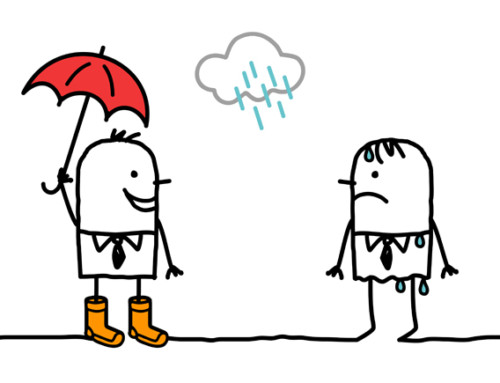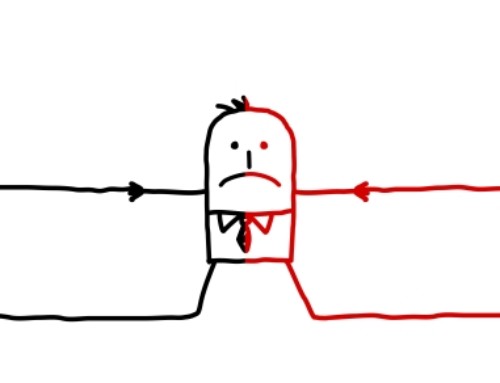In this article, I discuss how predicting negative events you may encounter and tracking those predictions can help you to manage the anxiety you experience in anticipation of these events.
Difficulties in managing anxiety are rooted in negative thinking patterns known as cognitive distortions. These distortions skew our perceptions of events in a negative direction which is not consistent the available evidence. In anxiety, these distortions involve skewed perceptions regarding negative events which may occur in our lives in the near or distant future. There are two cognitive distortions which drive anxiety to uncomfortable levels in anticipation of these events—‘overestimating danger’ and ‘underestimating coping’.
‘Overestimating danger’ occurs when you believe that a negative event is more likely to occur than the available evidence indicates. ‘Underestimating coping’ comes with it the view that you will not be able to cope with the event if it were to occur. Each of these cognitive distortions leads to uncomfortable levels of anxiety in anticipation of negative events. In turn, addressing these distortions is a primary cognitive skill to help a person lower anxiety to manageable levels.
There are a variety of tools to help in this endeavor which I use with my clients in anxiety counselling as part of my work as a Calgary psychologist and a Cochrane psychologist. One such tool is the ‘prediction log’. In the following sections, I will describe how this tool is used to lower anxiety by helping a person make a more accurate assessment of the likelihood of negative events occurring and increase their belief that they will be able to cope with these events if they were to occur.
How to complete the first two columns of the prediction log
The first two columns of the prediction log entail predicting negative events which lead you to experience strong anxiety along with your anticipated level of coping with these events. For example, if you were experiencing strong anxiety in advance of a presentation you were to make at work you might list in the first column of your prediction log the following negative events: ‘I will lose my train of thought’, ‘Someone will ask me a question I don’t know the answer to’, ‘The computer will malfunction’, and ‘I will have to go to the washroom’.
After listing these predicted negative events in the first column, in the second column you would rate on a scale of 1-10 how well you predict you will cope with the event if it were to occur with a higher number representing greater anticipated coping. For example, if you predict you would cope very well with the event, ‘Someone will ask me a question I don’t know the answer to’ you would rate your anticipated coping with a high number such as 8 or above. If you think you wouldn’t cope well at all if this event were to occur, you would give yourself a low number such as 3 or below. Once you’ve listed the predicted negative event in the first column and your predicted coping with these events in the second column, you are ready to complete the next two columns of the prediction log.

How to complete third and fourth columns of the prediction log
In the third and fourth columns of the prediction log, you indicate which of the predicted negative events from the first column (if any) occurred and how well you coped with those events which did occur. Specifically, you note beside each predicted negative event ‘Yes’ or ‘No’ to represent whether the event occurred. For example, if the event ‘I will lose my train of thought’ occurred during your presentation at work you would mark ‘Yes’ in the third column or ‘No’ in that column if this predicted negative event did not occur.
In the fourth column, you rate on a 1-10 scale how well you actually coped with each of those predicted negative events which did occur. For example, if the predicted event ‘Someone will ask me a question I don’t know the answer to’ occurs, you would rate how well you coped with this event with higher ratings indicating that you coped well and lower ratings indicating that you did not cope well. For example, if you coped well you might give yourself a rating of 7 or higher on the 1-10 scale. If you did not cope well when this event occurred, you would give yourself a rating to reflect this such as 3 or lower. If any of the predicted negative events you listed in the first column did not occur, you would not fill in the corresponding fourth column.
How to use the results of the prediction log to manage your anxiety
Analyzing your completed prediction log will help you manage anxiety by allowing you to counteract the tendency to overestimate the occurrence of negative events and to underestimate your ability to cope with them. Your ability to counteract the tendency to overestimate the occurrence of negative events will be enhanced by noting those instances in which you predicted negative events which did not occur. Having this experiential evidence of your tendency to ‘overestimate danger’ will make it less likely you will do so going forward. In turn, this should help to lower your anxiety to manageable levels.
Viewing your completed prediction log will also help you to counteract the tendency to underestimate your ability to cope with negative events which do occur. Such instances can be identified in your prediction log by your rating of actual coping in the fourth column exceeding your predicted coping rating in the second column. Having this experiential evidence of your tendency to ‘underestimate coping’ will make it less likely you will do so going forward. As with increased awareness of the tendency to overestimate danger, greater awareness of the tendency to underestimate coping should help to lower your anxiety to manageable levels.
Finally, your completed prediction log will provide you with additional help in lowering your anxiety to manageable levels by helping you to identify instances in which your actual coping rating in the fourth column is low. Spotting these cases will alert you to the need to prepare better coping strategies to deal with these negative events more effectively when they occur. Knowing that you have these effective coping strategies in place will allow you to reduce your anxiety to manageable levels in anticipation of these events’ occurrence on future occasions.
May your use of prediction logs allow you to sleep like a log,
Dr. Pat






Leave A Comment